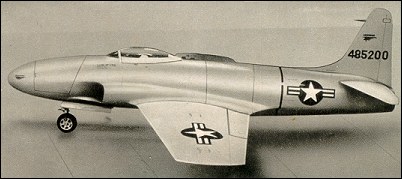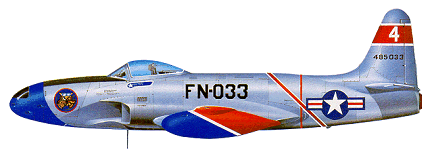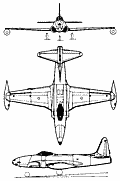 |
Lockheed F-80 Shooting Star1944 |  |
| FIGHTER | Virtual Aircraft Museum / USA / Lockheed |
 |
In June 1943 Lockheed was instructed to proceed with the design and development of a new single-seat fighter, utilising as its power plant a British de Havilland H-1 turbojet. This was undoubtedly an exciting project for Lockheed, for the first US-built turbojet-powered aircraft - the Bell XP-59A prototype - had made its maiden flight less than nine months earlier. At that time the tempo of American aircraft production had got into high gear and C. L. "Kelly'" Johnson, leader of Lockheed's design team, used his genius and enthusiasm to such effect that the project details had been completed within a week. The design proved acceptable to the USAAF. It was a low-wing cantilever monoplane with a knife-edge laminar-flow wing section; engine within the rear fuselage; air intakes on each side of the fuselage forward of the wing leading edge; and retractable tricycle-type landing gear. Equally attractive was the company's proposal to complete an initial prototype within 180 days and little time was lost in awarding contracts for three prototypes and 13 service trials aircraft. Work on the first prototype began in August 1943 and just 143 days later (on 9 January 1944) this aircraft flew for the first time. Service designation of the prototype was XP-80. Its power plant was a 13.34kN de Havilland H-1 turbojet, predecessor of the Goblin and supplied to the USA in July 1943. Unfortunately plans for this engine to be built by the Allis-Chalmers Company in America went awry, so the next two prototypes each had a 16.68kN General Electric 1-40 turbojet. This was a larger and more powerful engine than the intended Allis-Chalmers J36, involving redesign which included increased span and length, a taller fin and strengthened landing gear. The exercise cost five months, for it was not until 10 June 1944 that the first of these two XP-80A was flown. The YP-80A service trials aircraft, powered by Allison-developed General Electric J33, began to equip USAAF units in October 1944 but were too late to see operational service in World War II. The name allocated (Shooting Star) was indicative of the excitement generated by these new turbine-powered aircraft, able to demonstrate speeds of 160-240 km/h higher than those of the best piston-engined fighters. Because of such performance, war-end contract cancellations did not eliminate the P-80 (changed to F-80 in 1948), but ensured that production continued to re-equip USAAF first-line squadrons - beginning in December 1945. Production P-80A had wingtip tanks and provision for bombs, rockets and fuel tanks to be carried beneath the wings, plus six 12.7mm guns mounted in the fuselage nose. P-80B which followed had a more powerful engine, thinner wing section, stronger bulkheads in the nose section to support greater fire-power, stainless steel armoured engine compartment and provisions for JATO. Final version was the P-80C (RF-80C unarmed photographic reconnaissance sub-variant), with a still more powerful engine and increased underwing weapons capability. The Shooting Star has an established place in USAAF/USAF history: its first operational jet-powered aircraft, one of which set a world speed record of 1,003.91km/h on 19 June 1947. Soon after (in 1950) they were used in combat during the Korean War and an F-80C, flown by Lieut Russell J. Brown on 8 November 1950, achieved the first air-combat victory between two jet-powered fighters, destroying a Mikoyan MiG-15 of the Chinese People's Republic Air Force. For Korea, F-80 were adapted to carry two 227kg and four 118kg fragmentation bombs or two 450kg bombs plus eight rockets or four 40 US gallon napalm bombs. Variants have included reconnaissance RF-80, QF-80A and QF-80F drones, and one F-80C was converted as a prototype two-seat trainer.

|  COMPANY PROFILE | ||||||||||||||||||||||||||||||||||||||||||||||||||||||||||||
 |

|

